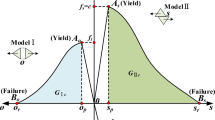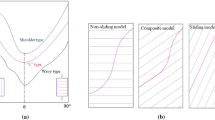Abstract
An empirical expression of cohesion (C) and friction angle) (ϕ for layered rock was suggested. This expression was compared with a test result made by the former researchers. The constitutive relationship of a transversely isotropic medium and Mohr-Coulomb criterion in which C and ϕ vary with directions were employed, and a relative 3D elasto-plastic FEM code was developed, in which the important thing was to adopt a search-trial method to find the orientation angle (ρ) of shear failure plane (or weakest shear plane) with respect to the major principal stress as well as the corresponding C and ϕ. Taking an underground opening as the calculation object, the numerical analyses were carried out by using the FEM code for two cases of transversely isotropic rock and isotropic rock, respectively, and the computation results were compared. The results show that when the rock is a transversely isotropic one, the distributions of displacements, plastic zones and stress contours in the surrounding rock will be non-axisymmetric along the tunnel’s vertical axis, which is very different from that of isotropic rock. The stability of the tunnel in transversely isotropic rock is relatively low.
Similar content being viewed by others
References
SERRANO A, OLALLA C. Ultimate bearing capacity of an anisotropic discontinuous rock mass. Part I: Basic modes of failure [J]. Int J Rock Mech Min Sci, 1998, 35(3): 301–324.
LEE Y K, PIETRUSZCZAK S. Application of critical plane approach to the prediction of strength anisotropy in transversely isotropic rock masses [J]. Int J Rock Mech Min Sci, 2008, 45(3): 513–523.
SAROGLOU H, TSIAMBAOS G. A modified Hoek-Brown failure criterion for anisotropic intact rocks [J]. Int J Rock Mech Min Sci, 2008, 45(3): 223–234.
XU Wei-ya, ZHANG Gui-ke. Study on orthotropic equivalent strength parameters of jointed rock mass [J]. Chinese Journal of Geotechnical Engineering, 2007, (6): 806–810. (in Chinese)
YANG Qiang, CHEN Xin, ZHOU Wei-yuan. Anisotropic yield criterion for jointed rock masses based on a two-order damage tensor [J]. Chinese Journal of Rock Mechanics and Engineering, 2005, 24(8): 1275–1282. (in Chinese)
YU Tian-tang. Modeling of inherent anisotropy for geotechnical material [J]. Chinese Journal of Rock Mechanics and Engineering, 2004, 23(10): 1604–1607. (in Chinese)
COLAK K, UNLU T. Effect of transverse anisotropy on the Hoek-Brown strength parameter ‘mi’ for intact rocks [J]. Int J Rock Mech Min Sci, 2004, 41(3): 1045–1052.
LYDZBA D, PIETRUSZCZAK S, SHAO J F. On anisotropy of stratified rocks: Homogenization and fabric tensor approach [J]. Computers and Geotechnics, 2003, 30(3): 289–302.
PIETRUSZCZAK S, LYDZBA D, SHAO J F. Modelling of inherent anisotropy in sedimentary rocks [J]. Int J Solids Struct, 2002, 39(3): 637–648.
USHAKSARAEI R, PIETRUSZCZAK S. Failure criterion for structural masonry based on critical plane approach [J]. J Eng Mech, 2002, 128(7): 769–778.
PIETRUSZCZAK S, MROZ Z. On failure criteria for anisotropic cohesive-frictional materials [J]. Int J Numer Anal Meth Geomech, 2001, 25(3): 509–524.
SMITH B, CHEATHAM B. Anisotropic compacting yield condition applied to porous limestone [J]. Int J Rock Mech Min Sci, 1980, 17(3): 159–165.
NOVA R. The failure of transversely isotropic rocks in triaxial compression [J]. Int J Rock Mech Min Sci, 1980, 17(6): 325–332.
JAEGER J C. Shear failure of anisotropic rock [J]. Geol Mag, 1960, 97: 65–72.
ZHANG Yu-jun, TANG Yi-xing. 2-D FEM analysis for an underground opening considering the strength-anisotropy of the layered rock mass [J]. Chinese Journal of Geotechnical Engineering, 1999, 21(3): 307–310. (in Chinese)
ATTEWELL B, SANDFORD R. Intrinsic shear strength of a brittle, anisotropic rock (I): Experimental and mechanical interpretation [J]. Int J Rock Mech Min Sci, 1974, 11(11): 423–430.
ZHOU Wei-yuan. Higher rock mechanics [M]. Beijing: Water Conservancy and Power Press, 1990: 116–119. (in Chinese)
OWEN J, HINTON E. Finite elements in plasticity: Theory and practice [M]. West Cross, Swansea: Pineridge Press Limited, 1980: 215-231.
BRADY G, BROWN T. Rock mechanics for underground mining [M]. Beijing: Coal Industry Press, 1990: 83–84. (in Chinese)
YU Xue-fu, ZHENG Ying-ren, LIU Huai-heng, FANG Zheng-chang. Stability analysis for surrounding rock masses of underground projects [M]. Beijing: Coal Industry Press, 1983: 505–508. (in Chinese)
Author information
Authors and Affiliations
Corresponding author
Additional information
Foundation item: Project(2010CB732101) supported by the National Basic Research Program of China; Project(51079145) supported by the National Natural Science Foundation of China
Rights and permissions
About this article
Cite this article
Zhang, Yj., Zhang, Wq. 3D FEM analysis for layered rock considering anisotropy of shear strength. J. Cent. South Univ. Technol. 17, 1357–1363 (2010). https://doi.org/10.1007/s11771-010-0642-x
Received:
Accepted:
Published:
Issue Date:
DOI: https://doi.org/10.1007/s11771-010-0642-x




